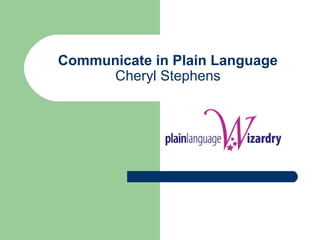
Plain Language 2016
- 1. Communicate in Plain Language Cheryl Stephens
- 2. Plain Language Solutions Agenda: Plain Language Process Writing Guidelines
- 3. Useable information Simply written Focused Clearly laid out
- 4. Elements Clear design Simple, logical, or familiar organization Simple or familiar format Plain language
- 5. The Reading Challenge Know typical reader’s: age, sex, race, ethnicity, language, education, training, lifestyle, work style, interest in process?
- 7. Reading the Challenge Document related: When will reader use it? Where? How? How long? Restrictions in law, deadlines, formats?
- 8. Be Brief Change The number of applications to schools of business is on the increase. to Business school applications are increasing.
- 9. Writing Guidelines Keep sentences under 25 words; aim for 15 words on average. Simplify sentence structures. Avoid negative words and sentences.
- 10. Writing Guidelines Write in the active voice. Know when to use the passive verb. Avoid turning verbs into nouns and nouns into verbs.
- 11. Writing Guidelines Use the 1st or 2nd person. Use simple names or labels. Choose words familiar to the reader.
- 12. Commandments for Plain Language Drafting Consider your reader; write to reader's point of view. Say what you have to say, and no more. The Canadian Bar Association /Canadian Bankers' Association
- 13. More Commandments Avoid strings of synonyms. Avoid unnecessary formality.
- 14. Even More Commandments Organize your text: in a logical sequence, with informative headings, and with a table of contents for long documents. Make the document attractive and designed for easy reading. The Canadian Bar Association/Canadian Bankers' Association
- 15. Choose Words Carefully Do not use jargon, archaic formalisms, or foreign terms. Avoid legal jargon. Use only necessary technical terms. Provide definitions if necessary.
- 16. A True Term of Art? A genuine, technical, term of art has an uncontroversial core meaning that cannot be conveyed succinctly in any other way.
- 17. Negatives Obvious negatives: no, never, and not… Words with negative implications: none, unless, until, fail, exempted, unlawful, invalid
- 18. Negatives limitation none prohibition unless until fail exempted unlawful invalid absent ambiguous avoid contrary delinquent deny doubt except fail forbid lack minimum no less than no more than no smaller than sanction shun transgression void
- 19. Negative vs Positive - This policy shall not be valid unless countersigned by our authorized representative. + This policy becomes valid when signed by our authorized representative.
- 21. Suffixes for Making Nouns from Verbs -archy -kinesis -phil- -cide -mania -phob- -cracy -nik -phone -cycle -graphy -polis -gate -oid -scope -genesis -logy -stan -hood -ome -ville -ic -omics -ware -illion -nomy -ism -onym -ist -ous
- 22. Nominalizations Acquisition Acquire Encouragement Encourage Action Act Implementation Implement Administration Administer Improvement Improve Assistance Assist Indication Indicate Authorization Authorize Difficulty Difficult Carelessness Careless Justification Justify Cessation Cease Notification Notify Coordination Coordinate Determination Determine Refusal Refuse Failure Fail
- 23. Don’t Make Nouns from Verbs
- 24. Convert Nominalizations When they made a decision... When they decided... The Court, in its ruling, held that... The Court ruled... Submit an application... Apply... Take into consideration... Consider...
- 25. Organization Organize the information, logic, and structure Put the topics in an order which suits your audience and purpose. Use indents and lists to visually display relationships. Use parallel forms of grammar for equivalent ideas.
- 26. Effective paragraphs Paragraphs develop a single idea through example, elaboration, and detail. Keep paragraphs short: – no more than 5-6 lines of text. Start from old information, then introduce new.
- 27. Effective lists Use lists with parallel grammar forms—when possible. Use three items in lists if you want them remembered. Rethink the categories to create shorter lists. Number a list of items only if it shows steps, priorities, or values. Use bullets.
- 28. Organization: Conceptual Use signal words to link and show the logical flow: Connections: so, also, besides, and then, next, still Differences: unless, but then, on the other hand Summary: finally, in brief, in short, to put it differently, in other words
- 29. Transitions… Preserve coherence through use of transitions, repeating key words and phrases, using pronoun references, and using parallel form
- 30. Transitions… (cont’d) Most people do not know that... These are the facts: 1) 2) 3) Given this situation... But this problem also arose because.... These steps should have been taken to solve the problem Smith might have tried... Sidhu could have... Kahn Inc. must now consider...
- 31. Design Enhance the message with – format – layout – design Use design to – emphasize – organize – illustrate content
- 32. Language Can Be Confusing Something Went Wrong in Jet Crash, Expert Says Police Begin Campaign to Run Down Jaywalkers Panda Mating Fails; Veterinarian Takes Over Teacher Strikes Idle Kids Miners Refuse to Work after Death Juvenile Court to Try Shooting Defendant War Dims Hope for Peace
- 33. Language Can Be Confusing (cont’d) Red Tape Holds Up New Bridges Man Struck By Lightning Faces Battery Charge Kids Make Nutritious Snacks Feed Needy Local High School Dropouts Cut in Half Hospitals are Sued by 7 Foot Doctors Typhoon Rips Through Cemetery; Hundreds Dead
- 34. Design: avoid blocks of text
- 35. Simple Design Remove clutter One main visual Use open space but consolidate it Use restraint Up to 3 type faces.
- 36. Use freely: Graphics Visual aids Tables Graphs Simple formulas
- 37. Readability Measures Desirable ranges for writing to adults: Flesch Readability Scale 60 -75 points Gunning's Fog Index in Years of Education Grade 6 to 8 Flesch-Kincaid Reading Grade Level 4 to 6 Average Sentence Length 15-20 words Passivity Index 0-35
